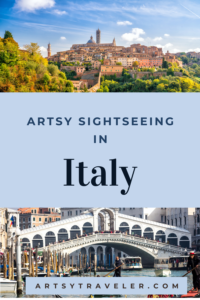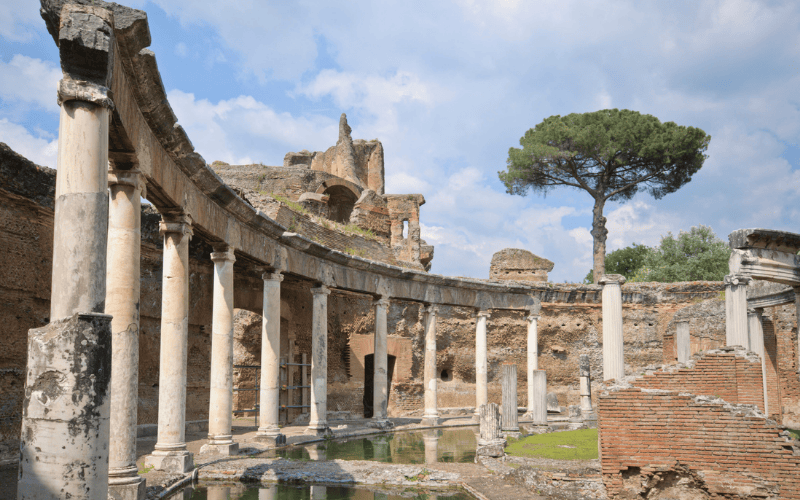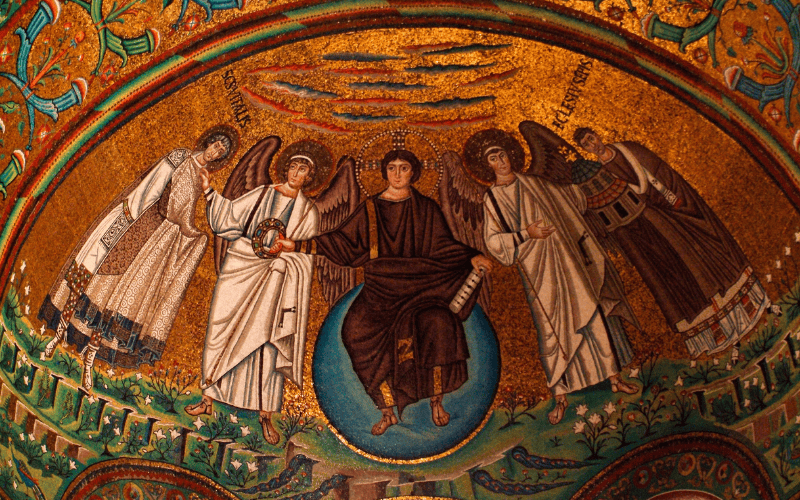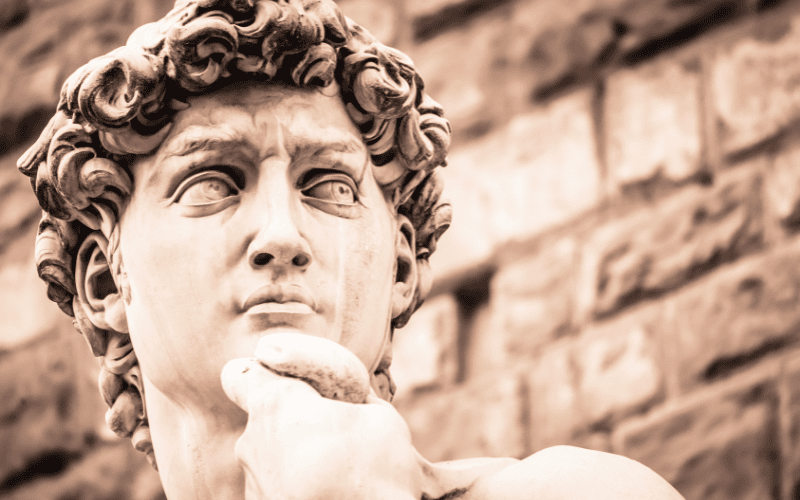Amazing Artsy Sightseeing Choices in Italy for the Independent Traveler
Where to begin when it comes to artsy sightseeing in Italy? Italy feels at times like one giant art gallery! There’s so much to see that even after numerous trips, I know I have many more wonders in store for me on future trips.
In this post I’ve described some of my favorites in eight historical periods: Greek, Etruscan, Roman, Byzantine, Medieval, Renaissance, Baroque, and 20th Century.
Read about my artsy sightseeing highlights and then follow links to more detailed recommendations. Seriously, you could very easily spend years in Italy and not run out of art to admire.

Map of Italy: Suggested Artsy Sightseeing Choices
The map below shows the locations of the artsy sightseeing options mentioned in this post. Click a number to read more about the location.
Greek Ruins
Three of the best preserved Greek temples in the world are located in Italy!
Ever since I first saw pictures of the magnificent Doric temples at Paestum (#1) in southern Italy, I’ve wanted to visit them–and finally I have!
The ruins are well worth the effort to get to them. Pictures give some idea of the beauty of the temples, but they cannot give a sense of the sheer size and splendor of the columns.
The temples are thought to be dedicated to the city’s namesake Poseidon (known to the Romans as Neptune), Hera and Ceres. The oldest temple dedicated to Hera dates from 550 BC.
Here are some options for touring Paestum with GetYourGuide.
Staying In Paestum
If you have a car, stay at the Savoy Beach Hotel. It’s on the Mediterranean and includes a beach club with loungers and people to bring you drinks! The hotel is luxurious, but the price is surprisingly reasonable.
Etruscan Art
I’ve grown very fond of Etruscan art. It’s different from Roman art in that it’s less monumental and more personal.
The Etruscans pre-date the Romans and were based around Florence and throughout Tuscany as far south as Tarquinia, about 50 kilometers north of Rome. The Etruscans were a fascinating society in which women held much more power than they did in Roman society.
I mention Volterra in the section on Tuscany. The Etruscan Guarnacci Museum is the place to see Etruscan artifacts.
Here are two other great options for enjoying Etruscan art while artsy sightseeing in Italy.
Tarquinia
All around Tarquinia are the ruins of Etruscan tombs, many with fabulous paintings. Visit the Necropolis of Tarquinia (#2) to see some of the most famous paintings including the Tomb of the Leopards which dates from 473 BC. The colors are remarkably well preserved.

Visit the museum in Tarquinia to see more Etruscan art. Fascinating.
National Etruscan Museum in Rome
We loved this place! The Museo Nazionale Etrusco (#3), housed in the lovely Villa Giulia, was virtually empty when we were there, which was a treat after visiting other museums in Rome. We wandered happily through room after room of Etruscan treasures including the famous Sarcophagus of the Spouses from the late 6th century BC.
Although we didn’t find the museum crowded, play it safe – skip the line and buy your tickets online.

I also enjoyed the urns and household goods, even little statues of animals. The Etruscan style is very modern-looking.
Ancient Roman
In addition to visiting the Roman sites in Rome and Pompeii, you don’t need to go far to find Roman ruins in Italy. Here are a few artsy sightseeing suggestions related to Roman art and architecture.
Hadrian’s Villa
Hadrian’s Villa (#4) is a massive archeological complex near Tivoli outside Rome. Designated a UNESCO World Heritage Site, the site is a must-see for fans of ancient Rome.
Be prepared to walk–the complex is vast, containing over 30 buildings and covering 250 acres, making it larger than the city of Pompeii. Stroll past the remains of fountains, pools, and gardens surrounding what must have been one heck of a pleasure palace back in the day.

Hadrian constructed the villa as a retreat from the tough work of emperor-ing during the second and third decades of the 2nd century AD. We first discovered the villa on our family trip to Italy in 1994. Since then, much more of the site has been excavated with more ruins yet to be uncovered.
TIP: A good strategy is to visit Hadrian’s Villa (also called Villa Adriana) and the Renaissance Villa d’Este on a day tour. Here’s an option.
Ostia Antica
Rome’s original seaport is 30 minutes from Rome by train. Ostia Antica (#5) is like a mini Pompeii but without all the tourists. If you’re not planning to go south, take an afternoon from your Roman sightseeing to check out the atmospheric ruins at Ostia Antica.
You’ll find a well-preserved Roman theatre, the Baths of Neptune, remains of the military camp, temples to ancient deities, the forum and even Ostia Synagogue, the oldest known synagogue site in Europe.
Baths of Caracalla
This complex of ancient public baths close to Rome is worth a visit. Several towering walls remain along with impressive black and white mosaics. Descend below ground to view the well-preserved tunnels where slaves worked to keep the baths operating and the water hot.
Buy tickets for the Baths of Caracalla (#6).
Archeological Museum of Naples
This museum is a relevation–and one of the best museums showcasing Roman-era art that I’ve every visited. The Archeological Museum of Naples contains much of the art–paintings, frescoes, objects, mosaics–recovered from Pompeii.
If you’re pressed for time and trying to decide whether to visit the Pompeii ruins or the archeological museum, my vote is the archeological museum. The ruins may be far more popular (and very crowded), but to get a comprehensive view of what life was like in Pompeii, the museum has it all.
Read my detailed post about the Archeological Museum of Naples (#7): How to See the Art of Pompeii at the National Archaeological Museum in Naples.
Staying in Rome
Here are two great options for staying in Rome:
- Sant-Angelo Apartments: located deep in the Jewish Ghetto, you’re within steps of most of the major sites in ancient Rome.
- Viam 6B located near the Spanish Steps and the Piazza del Popolo, this very stylish apartment is staffed, with some units including a lovely outdoor terrace.
Early Christian and Byzantine Art
Ravenna (#8) is the place in Italy to see the best Byzantine and early Christian mosaics. I wasn’t prepared for how incredibly new the mosaics looked. Despite dating from 400 to 600 AD, they looked like they were created yesterday.
I was taken with how the figures were depicted. Large eyes stare right at you, flowing robes glint with gold, the figures look like they could step from their perches on the walls high above you and join you for a glass of wine.
Be warned that many of the fabulous mosaics are located high up which means after a day of touring the UNESCO sites, you come away with a stiff neck.
It’s worth it! Artsy sightseeing doesn’t get much better than visiting the mosaics in Ravenna.

Here are some options for touring Ravenna with Get Your Guide.
Staying in Ravenna
If you’re driving, avoid the narrow Ravenna streets and stay a little ways outside the city. The Grand Hotel Mattei is a modern and comfy choice.
Medieval Era
If you’re an artsy traveler with a love of the medieval, you just need to look out the window in Italy. Okay, that’s not quite true, but if you stay in any hill town, you’ll be surrounded by buildings that date from the 1300s, if not earlier.
These are some of my favorite medieval artworks I seek out when sightseeing in Italy.
- Frescoes by Ambrogio Lorenzetti and Simone Martini in the Palazzo Pubblico (#9) in Siena
- The Maestà altarpiece by Duccio di Buoninsegna in the museum at the Siena Cathedral (#10)
- “The Annunciation” by Simone Martini in the Uffizi (#11) in Florence
- Frescoes by Giotto in the Basilica of Saint Francis of Assisi (#12)
- Frescoes by Giotto at the Scrovegni Chapel in Padua (#13)
- Frescoes by Memmo di Filippuccio in the Camera del Podestà in the Palazzo Comunale in San Gimignano (#14) showing domestic scenes including a couple taking a bath and getting into bed
For more details about seeing medieval art in Italy, read Ten Must-See Masterpieces in Tuscany.
San Gimignano 1300
And before I leave medieval art, I must put in a plug for San Gimignano 1300 (#15). This scale model of what San Gimignano looked like in 1300 is located near the Palazzo Comunale and the Torre Grosso in the center of San Gimignano. The display is free and well worth seeing to give you an idea of how the city of towers looked with 72 towers instead of its current 17.
And while you’re there, pick up a copy of The Towers of Tuscany.

Here are some options for touring San Gimignano and the area with Get Your Guide.
Staying in San Gimignano
My favorite place (perfect if you have a car) is the Hotel Pescille on the outskirts of San Gimignano and overlooking the towers. The Cappuccina Country Resort also overlooking the city is another good choice.
Renaissance Era
The Renaissance was born in Florence with an explosion of amazing art by artists such as Michelangelo, Botticelli, and Leonardo da Vinci. You’ll see a fair whack of the best stuff at the Uffizi.
TIP: If you go to the Uffizi, you must buy your tickets ahead of time, preferably a few days or weeks before you arrive, especially if traveling in peak season. Here’s a link to buy your tickets to the Uffizi and skip the line.
Here are some of my favorite Renaissance pieces (it’s just a partial list–I could go on and on!):
- Primavera and Birth of Venus by Sandro Botticelli in the Uffizi in Florence
- David statue by Michelangelo at the Academia (#16) in Florence
- David statue by Donatello at the Bargello (#17) museum in Florence
- Expulsion from the Garden of Eden by Masaccio at the Brancacci chapel (#18) in Florence
- The Medici chapels in Florence
- Sistine Chapel frescoes by Michelangelo at the Vatican (#19) in Rome
- Paintings by Sofonisba Anguissola, one of the few female painters from the period, in Siena and at the Uffizi in Florence.
For more artsy sightseeing in Florence, here are suggested tours and skip-the-line ticket options.
Staying in Florence
I highly recommend the Serristori Palace Residence. It’s right on the Arno River and slightly off the beaten track.
Baroque Era
Of all the art periods, the Baroque (roughly the 17th century) is my least favorite. I find the style too florid. However, the Baroque style is everywhere in Italy, from churches to museums. You can’t escape it.
Big names in Baroque art include Caravaggio, Tiepolo, Titian, Bernini, and Artemisia Gentileschi. Although Baroque art isn’t my cup of tea, I do love Artemisia’s work.
You can see her masterpiece, Judith Slaying Holofernes, completed in 1610, in the Uffizi Gallery in Florence.
Modern Art in Italy
Italy has produced several noted modern artists including Giacometti, Modigliani, and Futurists such as Severini, Marinetti, and Balla. Following are three places to see wonderful modern art in Italy (and again, there are many more).
Peggy Guggenheim Museum
Located right smack on the Grand Canal in the Dorsoduro district of magical Venice between Santa Maria della Salute and the Gallerie dell’Accademia, the Peggy Guggenheim Museum (#20) just makes me smile. I can’t visit it often enough!
The museum houses Peggy Guggenheim’s personal collection of 20th- century art including masterpieces of cubism, surrealism and abstract expressionism. Artists in the permanent collection include Picasso, Kandinsky, Miró, Braque, Giacometti, Klee, Magritte, Dali, Pollock, de Chirico, Brancusi, Braque, Duchamp, and Mondrian. It is an embarrassment of 20th-century riches.
If you’re in Venice, take a break from the Renaissance and cross the canal to visit the Peggy Guggenheim Museum. Wander the cool halls of her renovated palazzo to view the paintings and sculptures and then descend the steps to the edge of the canal and watch the boats go by.
I include the Peggy Guggenheim museum in my post about the Top Ten Modern Art Museums in Europe. Buy advance tickets (recommended in peak season) here.
National Museum of Modern Art in Rome
Also included in Top Ten Modern Art Museums in Europe is Rome’s National Museum of Modern Art (Galleria Nazionale d’Arte Moderna (#21). The museum is conveniently located on the edge of the Villa Borghese so you can see it before or after you visit the Galleria Borghese
Read my description in Ten Great Ways to Enjoy Bella Roma.
The museum features an excellent collection of 20th-century Italian painters including Giorgio de Chirico, Amedeo Modigliani, Antonio Canova, Giacomo Balla, and Giorgio Morandi, along with works by Rodin, Degas, van Gogh, Monet, Duchamp, Man Ray, and Pollock.
Unlike the Vatican and the other Renaissance and Ancient Roman attractions of Rome, the museum is sparsely attended and, therefore, extremely pleasant.
Tarot Garden: Sculptures by Niki de Saint Phalle
Located near the coast in the province of Grosseto in Tuscany, the Tarot Garden (Il Giardino dei Tarocchi – #21) is a collection of sculptures created by the French artist Niki de Saint Phalle.
If you’re traveling through Italy by car, carve out time to visit this wonderful place. For a great, although long, day trip from Rome, catch the train from Rome Termini to Orbetello Stazione (about 90 minutes) and from there take a taxi or a bus.
For a detailed description of how to get from Rome to Il Giardino dei Tarocchi, check out this post on The Spotted Cloth website.
Pictures of Il Giardino dei Tarocchi don’t do the sculptures justice. If you love quirky, whimsical modern art, you have to go and see the sculptures for yourself. You can walk around them, touch them, even go inside some of them.

Il Giardino dei Tarocchi is far enough off the beaten path to be uncrowded and totally delightful.
The garden is open every afternoon from 2:30 pm to 7:30 pm from April 1 to October 15. In November, December, January and March, the garden is open on the first Saturday of the month from 9 am to 1 pm. If the Saturday falls on a public holiday, the park opens the following Saturday.


Check the website for more information and directions.
Exploring the Area
Here are some GetYourGuide tours in Italy.
Conclusion
Have you visited any of the places described in this post? If so, let other artsy travelers know what you think.
Here are some more posts on Italy to help you plan your next trip–or just to indulge in some armchair travel.
